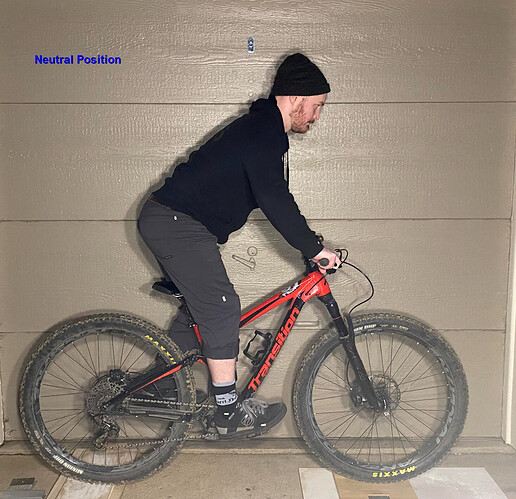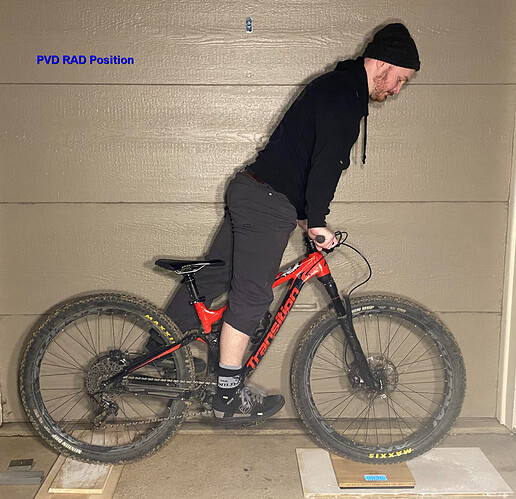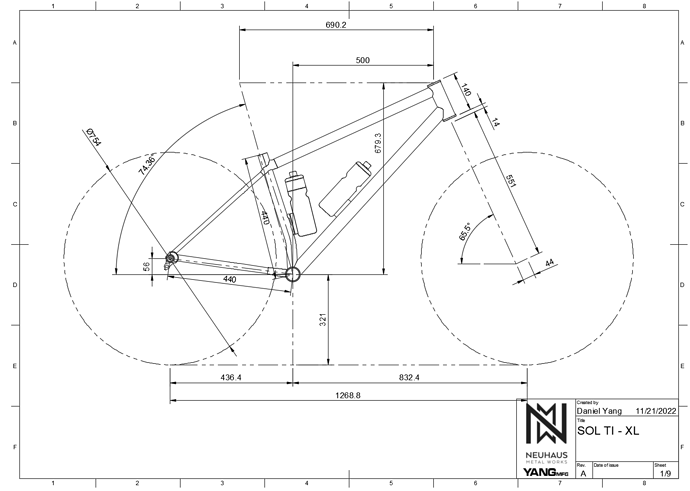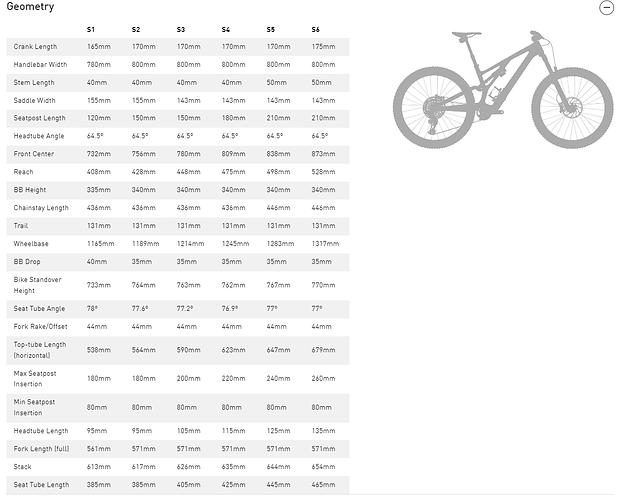Jeezy Creezy ya’ll make me swoon when you talk nerdy!
I remember that article! It definitely inspired my rabbit hole.
Between PVD, the geometry Vorsprung video, and cadaver data for average body segment masses, I built a spreadsheet using PVD’s RAD to calculate a size run based on CoM: Tuesday Tune - COM
My neighbor (a next level bike/science nerd who likes to help) and I set up a flat land weight distribution test to validate the output of the spreadsheet. (Sorry about the photo quality, we were outside in January with a house lamp ![]() )
)
The assumption was by using a known geometry and fit for a bike, if the measured weight distribution matched the geometry output from the spreadsheet, then the method would be sound.
What ended up happening is the positional assumption of PVD’s RAD was the incorrect model. The spreadsheet matched the measurement data in this position, but looking at the photos, no one rides around like that. A similar method built around the neutral position would be more meaningful, but haven’t revisited the project.
This recent Pinkbike opinion got me thinking about the CoM topic again. Specifically the linked video about 50/50 weight splits in cars, but viewed from a weight shift perspective.
For suspension kinematics, anti-squat and anti-rise help to combat weight shift during acceleration and deceleration.
- Can FC/RC ratio be used in tandem to create a desired weight distribution/tire grip during these shift events?
This is an interesting position to take. I don’t agree or disagree with you. It’s just food for thought.
We’re out of the saddle mostly during descents. When we’re out of the saddle we have the greatest ability to affect weight distribution.
It’s when we’re seated on climbs that we have the least ability to move our weight.
For anything but park/enduro/dh bikes, should we not focus more on the position that we have least weight distribution control over?
Here’s an anecdote that probably means nothing ![]()
I’ve made hardtails for two friends. They are both advanced riders who can ride pretty much anything on a hardtail. One is 5’7" and the other is 6’3". The short dude rides a 760FC/425RC bike for a FR ratio of 1.79. The big boy rides a 838FC/430RC bike at FR ratio 1.95.
Shorty rides like a jackrabbit, bouncing off all the features. Big Boy is a bruiser going down. He tends to straight line stuff more. Even though Shorty has more weight on his front wheel, he’s still able to bunny hop and get his front wheel over stuff.
On the climbs, Shorty can cruise up everything. He’s never complained to me about rear wheel traction or the front wheel lifting. Big Boy struggles up the steep climbs because his front wheel is so eager to lift up.
I don’t know what I’m trying to get at except I think tall riders on hardtails should really consider running longer chainstays. The tall riders will have to get used to a more weighted front wheel, but they also have the length to make a greater change to weight distribution when standing.
Whether we use a consistent FR ratio OR determine a good looping angle at the CoM remains to be discussed. However, I think we shouldn’t dismiss seated CoM for trail bikes.
I’ve read bits and pieces of his work online but not the book. What are your big takeaways from the book?
Not to digress too much, but the book is an astounding reference for suspension kinematic design and the mathematics of singletrack vehicle handling. It’s pretty dense to read cover-to-cover but is great as a reference. No one really writes about bicycles in the same way. I had a full PDF at some point, let me see if I can dig it up agian.
That’d be awesome! In my past life, I did all sorts of simulations including vehicle dynamics (of cars mainly) but I could never really wrap my head around how a single track vehicle with a fully active rider climbing around on it actually works…
Thanks for sharing that experiment. The PVD RAD position can also be called the torpedo.
I tried the scales experiment several times, but it was inconclusive. I could never exactly replicate the position and weight distribution consistently.
This why I use RFR through the BB:
- To me a good fit for descending encourages heavy feet and light hands. That means it means most of your weight is going through your feet, and through the BB
- RFR is an approximation of the COM location. RFR relative to the BB is a consistent and easy-to-measure metric. Can you measure the COM? Even with scales, I was unable to get anything accurate.
I know this may be blasphemous, but I only use weight balance to tune the climbing performance of a bike. To me, riding a hardtail is about climbing and descending. If purely descending focused, full suspension will do a better job for less money.
John is a weird outlier in body morphology. All torso and arms. He is 6’2ish with a low 780mm saddle height. IMO bikes just climb differently when your proportions stray away from the norm.
An example:
Somewhat related, I just went through the RFR calculation to design a titanium XL Solstice (ignore the geo chart, it is 2 years out of date).
- First, I determine the appropriate saddle position, stack, and reach
- My limit of RFR is 1.90. Anything beyond that, the front lifts on climbs and tucks too easily on descents. Keep in mind, >6ft tall people have much higher COM.
- I started with 65HTA and 440cs. That gave an RFR = 1.93 - too much
- Keeping 65HTA and extending the stay to 445cs gave RFR = 1.9
- steepening to 65.5HTA and 440CS gave RFR = 1.9
In the end, I chose 65.5HTA and 440CS to keep the wheelbase in check:
I definitely agree, I just haven’t put as much thought into it on my personal bikes (yet). I’m also a recovering single-speeder, so I still do all of my techy climbs out of the saddle and in a higher gear, using body english to keep traction.
Leonard Zinn has interesting stuff on this that agrees with your POV. His crit/road bikes have long stays, high BBs, long (185!) cranks. Larger wheels are a challenge because of tire/rim choice but I think I read an interview with him a while back that said he’d go larger wheels if they were readily available. I know for my bikes, I try to bias toward longer stays.
We’re in total agreement! I certainly did oversimplify my position:
My focus is on full suspension mountain bikes, with primary design intention for downhill performance.
For bikes intended for a 50/50 split, or some other combination, of climbing and descending, seated COM should absolutely be taken into consideration and, to @Daniel_Y 's method, is most likely directly over the BB shell.
With full suspension design, how the COM is defined becomes critical as it creates the relative reference frame that the kinematics are based from. 100% anti-squat/anti-rise is a 90-deg intersection point of COM and front contact patch. The purpose for anti-squat and anti-rise characteristics are to combat the weight shift of the system COM.
Intuitively, this example makes perfect sense to me based on my experiences too.
We were not able to directly measure COM location, but were able to validate the segmented body length calculation method for finding a COM location. Even if the calc was based around the incorrect model (I LOVE the torpedo name ![]() ) It gives me enough confidence to try again.
) It gives me enough confidence to try again.
In an effort to keep body position the same, we used pieces of tape to mark our body segment landmarks that I could then trace back in CAD after the fact to check how much variation our positions had. This wasn’t the most consistent since some of the tape either fell off or got covered up by clothing ![]() but could be kept more accurate with a motion camera system such as the Retul system I’ve used in the past.
but could be kept more accurate with a motion camera system such as the Retul system I’ve used in the past.
Personally, I agree that everyone should be riding size specific chainstay lengths. As a smaller rider, I often wonder how much of my experience transitioning to modern/longer reaches on mountain bikes was less about fit and space for me personally and more about weight distribution ratios. Eg. I currently prefer a reach of roughly 430mm, which is very close to historical/current chainstay lengths of 425-435mm from larger manufacturers.
Interesting discussion!
I think the COM position when talking about anti squat, anti rise, etc. is an assumption for comparison’s sake. We need to make assumptions about the position or else how would we compare or analyze the geo and kinematics when every designer has a different COM position. I think there are errors with this assumption but it is somewhat necessary, imo.
With the DH race team I work with we use a lot of data acquisition in addition to the rider feedback. We try and get a balanced bike for grip purposes. In the last few years as reach got longer we had to make longer chainstay to keep the weight on the front tire. Head angles also got slightly steeper as well in the last 2 years. For the race team, we have 3 different length seatstays with 2 positions each and 5 front triangles in order to find that nice and balanced bike.
In our testing, a balanced bike has more grip than a rearward biased setup for example. In heavy g-out situations the front wheel pushed wide if there is too much of a rearward bias. Tucking in is also bad but on the other extreme when you have too much weight on the front tire. We use different springs, damping, bars, stems and geometry to dial in the bike for the rider and the track. Dynamic vs static blah blah blah……
Recently we’ve been running 455 & 460mm chain stay length (this surprises me!) with a slightly higher bb to get the COM further forward and in between the wheels. I used to love short chain stays 425/435mm max and now I ride mainly 460mm. I figured out how to manual and play on the long stays so all my issues are gone and the increased grip is undeniable.
Thanks for the insider insight! Did the riders and designers ever express concerns of the entire wheelbase being too long? This is always my struggle with XL+ frames, they start approaching 1300mm wheelbases to be “proportional”
I’d rather see a tall rider on an XL+ with a wheelbase that is ‘proportional’ and have them have a bike that rides great than restrict them to a shorter wheelbase. Current 130mm trail frame I’m designing for a 6’4" dude is at 1312mm wheel base with 450mm chainstays but it’s going out to 455 in the next design revision. He’s not a jam it in the corners jumping around kind of guy but likes to go fast (current state level rally car champ in an Evo 9) so havng abike that is stable and not going to pitch him around when in the chunk is important. Having him on a shorter wheelbase with the height of his CoG would be like putting one of us average height riders on a bike that would have a wheelbase like an XS frame. Would not be fun to ride.
Yes, the XL front end is too long for most of them. However, the longer chain stays bring some welcomed stability and balance. The 455/460mm long chain stays are easier to get used to than the XL front triangle with 500mm reach, in my case. Even the riders on a shorter 445/460mm reach are liking the 455mm long chain stay. They are sometimes running angled headset .5 to 1* degree steeper if they feel like the bike is too long and sluggish.
I just had a little revelation after thinking about this thread. I watched a pinkbike video recently on geo for smaller mtbs. The lady mentioned she still preferred 29" wheels in the front for the usual reasons. Smoothing out bumps, etc.
This seemed strange to me because it’s really hard to keep the stack height proportionately low with the big wheel + travel on a suspension fork. For me as a 6ft tall, size L riding individual, I can’t keep traction on my front wheel when my front end is up too high. Especially in corners.
Ok so to actually connect this to chainstays. Since smaller stock frames have proportionately longer chainstays than larger ones, they are weighting the front wheel more. This compensates for the proportionately taller front end.
Am I off base here or does that check out?
When I turned spanners in a shop and could finally afford a new dually, I picked up an old stock Marin mt vision from the local distributor in… XS. It was mega cheap. I’m a ‘normal’ 1.8m guy and that thing was FUN ![]()
Loved it, 26 and all.
Correct. The static weight distribution depends on the front center - rear center ratio, detailed in this post
Looking at a Stumpy Evo:
| Size | FC | RC | RFR | % weight on front wheel |
|---|---|---|---|---|
| S1 | 732 | 436 | 1.68 | 37.3% |
| S2 | 756 | 436 | 1.73 | 36.6% |
| S3 | 780 | 436 | 1.79 | 35.9% |
| S4 | 809 | 436 | 1.86 | 35.0% |
| S5 | 838 | 446 | 1.88 | 34.7% |
| S6 | 873 | 446 | 1.96 | 33.8% |
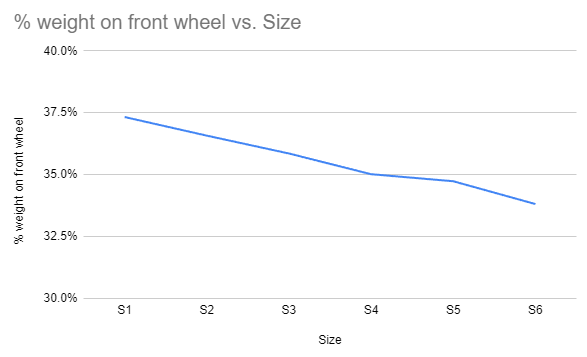
It may seem like a minor change, but it all adds up!

